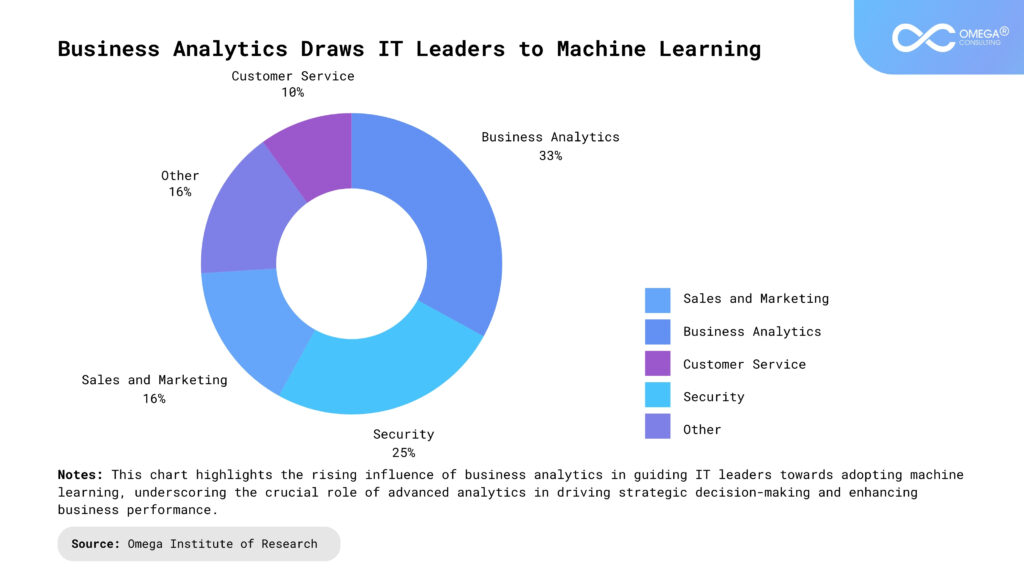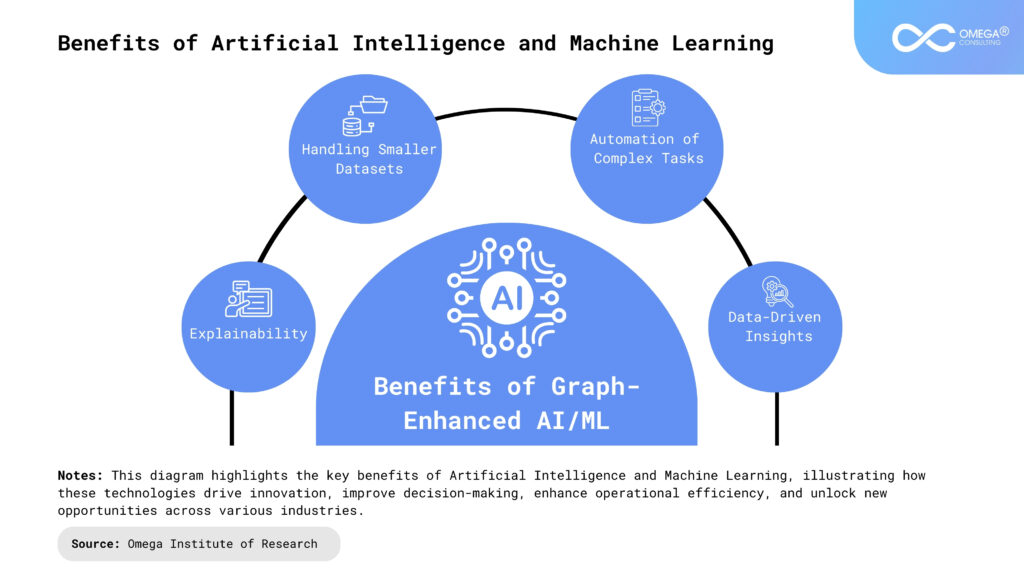- Industries
Industries
- Functions
Functions
- Insights
Insights
- Careers
Careers
- About Us
- Technology
- By Omega Team

As we forge deeper into the 21st century, the confluence of Artificial Intelligence (AI) and Machine Learning (ML) is fundamentally altering the landscape of business analysis. These advanced technologies are not only transforming how businesses interpret data but are also reshaping decision-making processes, strategic planning, and operational efficiencies. This article delves into the profound impact of AI and ML on business analysis, exploring their capabilities, benefits, challenges, and future potential.
The Transformation of Business Analysis
Business analysis has traditionally involved examining historical data, identifying patterns, and making recommendations to enhance organizational performance. Analysts relied on a mix of statistical techniques and manual processes to derive insights. However, the advent of AI and ML has introduced a new paradigm, marked by advanced computational techniques and unprecedented data processing capabilities.

AI and ML: Catalysts of Change
Advanced-Data Processing
In the pre-AI era, analyzing large datasets was a cumbersome process involving extensive data cleaning, aggregation, and statistical analysis. With AI and ML, businesses can now harness the power of advanced algorithms to process vast amounts of structured and unstructured data with remarkable speed and accuracy. Machine learning models can analyze diverse data types—including text, images, and audio—providing a more comprehensive view of business operations and customer behavior.
For instance, AI-driven data analytics platforms can automatically clean and preprocess data, eliminating the need for manual intervention and significantly reducing the time required to generate actionable insights. This capability is particularly valuable in industries such as finance, healthcare, and e-commerce, where timely data analysis can have a direct impact on decision-making and operational efficiency.
Predictive and Prescriptive Analytics
Predictive analytics, powered by machine learning algorithms, has become a game-changer in business strategy. By analyzing historical data and identifying patterns, predictive models can forecast future outcomes with a high degree of accuracy. This capability is particularly useful for forecasting sales, managing inventory, and assessing market trends.
Prescriptive analytics takes this a step further by recommending specific actions to optimize outcomes based on predictive insights. For example, retail businesses can use prescriptive analytics to determine the optimal stock levels for different products, minimizing both overstock and stockouts. Similarly, in the financial sector, prescriptive models can suggest investment strategies based on market predictions.
Automation of Routine Tasks
AI and ML have revolutionized business analysis by automating routine tasks that were once time-consuming and prone to human error. For example, AI-powered tools can automate data entry, report generation, and even complex analytical tasks. This automation not only enhances operational efficiency but also allows analysts to focus on higher-value activities such as strategic planning and decision-making.
Machine learning algorithms can also be employed for real-time anomaly detection, automatically identifying deviations from expected patterns and flagging potential issues. This capability is crucial for applications such as fraud detection, network security, and quality control, where early detection can prevent significant losses or disruptions.
Enhanced Personalization
In the age of AI, personalization has become a cornerstone of customer engagement. Machine learning algorithms analyze customer data to create highly personalized experiences, from targeted marketing campaigns to customized product recommendations. For instance, streaming services like Netflix and Spotify use AI to suggest content based on user preferences, while e-commerce platforms like Amazon provide personalized product recommendations.
The ability to deliver personalized experiences enhances customer satisfaction and loyalty, leading to increased engagement and revenue. Businesses that leverage AI for personalization can better understand their customers’ needs and preferences, allowing them to tailor their offerings and communications more effectively.
Real-Time Insights and Decision-Making
One of the most significant advantages of AI and ML is the ability to provide real-time insights. Traditional business analysis methods often rely on historical data and periodic reporting, which can lead to delays in decision-making. In contrast, AI-powered analytics platforms offer real-time data processing and reporting, enabling businesses to make informed decisions quickly.
Real-time insights are particularly valuable in dynamic industries such as finance and retail, where market conditions can change rapidly. By leveraging AI to monitor and analyze data in real-time, businesses can respond more effectively to emerging trends, customer behaviors, and market opportunities.

The Benefits of AI and ML in Business Analysis
Improved Accuracy and Precision
AI and ML algorithms are designed to analyze data with a high degree of accuracy, reducing the likelihood of errors and biases that can arise from manual analysis. Machine learning models can identify subtle patterns and correlations that may not be apparent through traditional methods, leading to more accurate insights and predictions.
Scalability and Efficiency
AI and ML solutions are inherently scalable, allowing businesses to handle increasing volumes of data and more complex analyses without significant additional resources. This scalability is particularly important for organizations experiencing rapid growth or operating in data-intensive industries.
Moreover, AI-powered tools streamline data processing and analysis, enhancing overall efficiency and productivity. By automating routine tasks and optimizing workflows, businesses can achieve greater operational efficiency and allocate resources more effectively.
Data-Driven Decision Making
AI and ML enable data-driven decision-making by providing empirical evidence and actionable insights. Businesses that embrace AI-driven analytics can base their decisions on data rather than intuition, reducing the risk of errors and enhancing strategic planning.
Competitive Advantage
Organizations that effectively leverage AI and ML gain a competitive edge by optimizing operations, improving customer experiences, and identifying new opportunities. The ability to analyze data more comprehensively and act on insights more quickly can be a significant differentiator in today’s competitive market.

Challenges and Considerations
Data Quality and Governance
The effectiveness of AI and ML depends on the quality of the data used. Inaccurate, incomplete, or biased data can lead to misleading insights and decisions. Businesses must invest in data governance practices to ensure data accuracy, consistency, and compliance with privacy regulations.
Skill Gaps and Talent Acquisition
Implementing AI and ML solutions requires specialized skills and expertise. Organizations may face challenges in acquiring and retaining talent with the necessary data science and machine learning skills. Investing in training and development programs, or partnering with external experts, can help address this challenge.
Integration and Implementation
Integrating AI and ML solutions with existing business systems and processes can be complex. Organizations must ensure that these technologies align with their current infrastructure and workflows to avoid disruptions. A well-defined implementation strategy and robust change management practices are essential for successful integration.
Ethical and Privacy Concerns
The use of AI and ML raises ethical questions related to transparency, accountability, and privacy. Businesses must address concerns such as algorithmic bias, data security, and the responsible use of AI. Adopting ethical guidelines and ensuring transparency in AI decision-making processes are crucial for maintaining trust and compliance.
Case Studies
Retail: Walmart’s Demand Forecasting
Challenge: Walmart, one of the largest retail chains globally, faced challenges in accurately forecasting demand for its extensive inventory. Traditional forecasting methods were often based on historical sales data, which proved insufficient for predicting demand in real-time, especially with seasonal variations and changing consumer preferences.
Solution: Walmart implemented machine learning algorithms to enhance its demand forecasting capabilities. By leveraging AI, Walmart analyzed vast amounts of data, including sales history, weather patterns, local events, and even social media trends. This holistic approach allowed for more precise demand predictions.
Outcome: The implementation of AI-driven demand forecasting led to a significant reduction in inventory costs and stockouts. Walmart was able to optimize its supply chain, ensuring that products were available in the right quantities at the right locations. This not only improved customer satisfaction but also increased operational efficiency and profitability.
Finance: JPMorgan Chase’s Fraud Detection
Challenge: JPMorgan Chase, a major global financial institution, faced the ongoing threat of fraudulent transactions. Traditional fraud detection methods were reactive and often failed to identify fraudulent activities in real time.
Solution: JPMorgan Chase adopted machine learning models to enhance its fraud detection capabilities. The models were trained to identify patterns and anomalies in transaction data, flagging potentially fraudulent activities with greater accuracy. The system used historical data and behavioral analysis to continuously improve its detection algorithms.
Outcome: The implementation of AI-driven fraud detection systems resulted in a significant reduction in false positives and an increase in the detection rate of fraudulent transactions. This proactive approach not only improved security but also reduced the financial losses associated with fraud.
Healthcare: IBM Watson’s Cancer Diagnosis
Challenge: In the healthcare sector, diagnosing cancer accurately and quickly is crucial for effective treatment. Traditional diagnostic methods were often time-consuming and reliant on the expertise of radiologists.
Solution: IBM Watson, an AI-powered platform, was used to assist in cancer diagnosis. Watson analyzed medical records, clinical trial data, and research papers to provide insights and recommendations for diagnosing and treating cancer. The system used natural language processing to interpret unstructured data from medical records.
Outcome: IBM Watson’s AI-driven diagnostic tool improved the accuracy and speed of cancer diagnoses. The system helped oncologists identify treatment options and potential clinical trials more effectively, leading to better patient outcomes and more personalized treatment plans.
E-commerce: Amazon’s Recommendation Engine
Challenge: Amazon, a global leader in e-commerce, sought to enhance the customer shopping experience by providing personalized product recommendations. Traditional recommendation systems were limited in their ability to deliver highly relevant suggestions.
Solution: Amazon leveraged machine learning algorithms to develop a sophisticated recommendation engine. The system analyzed customer behavior, purchase history, and browsing patterns to generate personalized product recommendations. It also used collaborative filtering to suggest products based on similar customers’ preferences.
Outcome: Amazon’s recommendation engine significantly boosted sales and customer engagement. The personalized recommendations increased the likelihood of additional purchases and improved the overall shopping experience, contributing to Amazon’s dominance in the e-commerce market.
Future Trends
Generative AI and Creativity
Trend: Generative AI, including models like GPT-4 and beyond, is poised to revolutionize content creation and business analysis. These AI models can generate human-like text, create visual content, and even design new products.
Implications: Businesses will increasingly use generative AI for tasks such as automated report generation, content marketing, and product design. This technology will enable more efficient and creative processes, allowing businesses to produce high-quality content and innovative solutions faster.
Explainable AI (XAI)
Trend: As AI systems become more complex, the need for transparency and interpretability in AI decision-making processes is growing. Explainable AI (XAI) focuses on making AI models and their decisions more understandable to humans.
Implications: Businesses will adopt XAI to build trust in AI systems and ensure compliance with regulations. Enhanced interpretability will enable stakeholders to understand how AI models arrive at their conclusions, fostering greater confidence in AI-driven decisions and improving accountability.
Edge AI and Real-Time Processing
Trend: Edge AI refers to the deployment of AI models on local devices rather than centralized servers. This approach enables real-time data processing and analysis at the edge of the network, closer to the data source.
Implications: Edge AI will enhance real-time decision-making in applications such as autonomous vehicles, IoT devices, and industrial automation. By processing data locally, businesses can achieve faster response times, reduce latency, and improve operational efficiency.
AI-Driven Business Process Automation (BPA)
Trend: Business Process Automation (BPA) is evolving with the integration of AI and ML technologies. AI-driven BPA solutions can automate complex workflows, enhance decision-making, and optimize business operations.
Implications: Businesses will increasingly adopt AI-driven BPA to streamline processes such as customer service, supply chain management, and financial operations. AI-powered automation will lead to greater efficiency, cost savings, and improved accuracy in various business functions.
AI and Data Privacy
Trend: As AI systems become more pervasive, concerns about data privacy and security are intensifying. Businesses will need to address privacy challenges while leveraging AI technologies.
Implications: The development of privacy-preserving AI techniques, such as federated learning and differential privacy, will become crucial. These approaches allow organizations to analyze data without compromising individual privacy, ensuring compliance with data protection regulations and building customer trust.
Conclusion
AI and ML are revolutionizing business analysis by enhancing data processing, enabling predictive analytics, automating decision-making, and providing personalized customer experiences. While these technologies offer significant benefits, businesses must navigate challenges related to data quality, skill requirements, integration, and ethics. By leveraging AI and ML effectively, organizations can unlock new opportunities, drive growth, and maintain a competitive edge in the modern business landscape.
- https://www.h2kinfosys.com/blog/the-future-of-business-analysis-in-the-age-of-artificial-intelligence-ai/
- https://www.batimes.com/articles/how-ai-will-affect-business-analysis-in-2024/
- https://medium.com/@techcanvassacademy/can-ai-and-machine-learning-elevate-business-analysis-practices-e2f9c3aeaafc
- https://ijcjournal.org/index.php/InternationalJournalOfComputer/article/view/2087
- https://www.dataversity.net/business-analyst-world-artificial-intelligence-machine-learning/
Subscribe
Select topics and stay current with our latest insights
- Functions